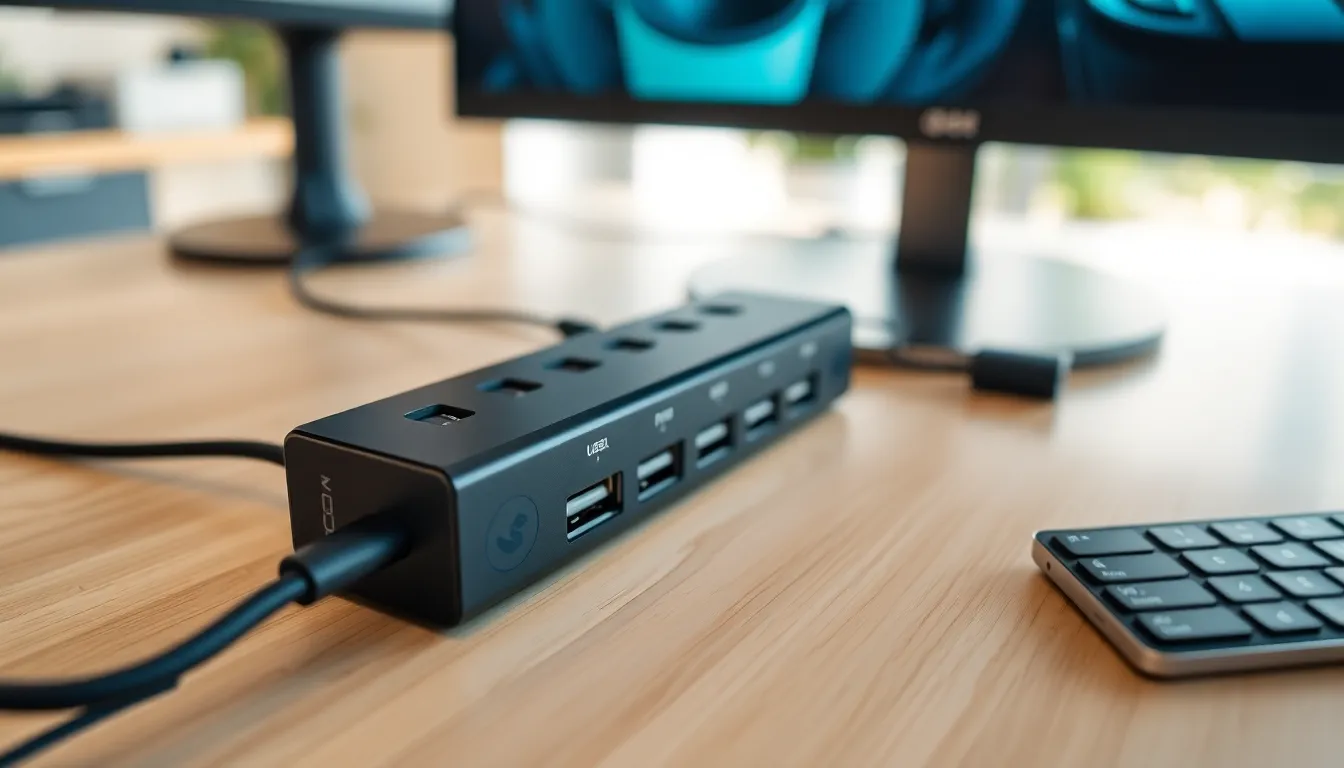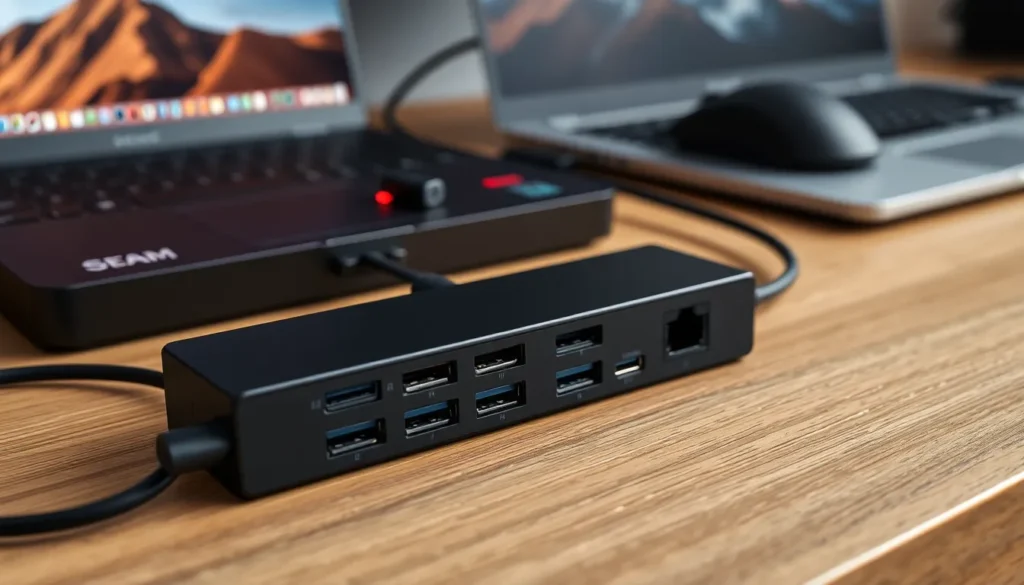Table of Contents
ToggleIn the world of handheld gaming, the Steam Deck has made quite the splash. But let’s face it, even the most powerful gaming device can feel a bit lonely without its trusty accessories. Enter the USB-C hub—a gamer’s best friend that transforms the Steam Deck from a solo act into a full-blown gaming orchestra.
Imagine connecting all your favorite peripherals with just one sleek device. Whether it’s a keyboard, mouse, or even a second monitor for those epic gaming marathons, a USB-C hub turns your Steam Deck into a versatile powerhouse. Plus, it’s the ultimate conversation starter at your next gaming night. “Oh, you’re still using a single USB port? How quaint!” So, let’s dive into why a USB-C hub isn’t just an accessory, but a game-changing upgrade for every Steam Deck owner.
Overview of the Steam Deck USB-C Hub
The Steam Deck USB-C hub significantly enhances functionality and versatility. Gamers benefit from the ability to connect various peripherals and expand their gaming setups.
Key Features
A Steam Deck USB-C hub generally includes multiple USB ports, HDMI output, and Ethernet connectivity. Users connect keyboards, mice, and external storage devices through these ports. Power delivery capabilities permit charging the Steam Deck while gaming. Some hubs offer additional features like SD card slots for easy file transfer. With robust build quality, many hubs stand up to frequent use, ensuring reliability during long gaming sessions.
Compatibility
Compatibility varies by hub model, but most support the Steam Deck directly. Many models align with USB-C standards, allowing connections to various peripherals seamlessly. Additional devices, like monitors and projectors, connect through HDMI ports. Operating systems typically recognize these connections without significant configuration adjustments. Some hubs even work with other devices, such as laptops and tablets, broadening usability. Always check specifications to ensure optimal performance with specific hardware.
Performance Review

The performance of a USB-C hub significantly impacts the user experience with the Steam Deck. Users often prioritize data transfer speeds and charging capabilities when selecting a hub.
Data Transfer Speeds
Data transfer speeds vary by USB-C hub model. Many hubs deliver USB 3.0 speeds, allowing users to achieve up to 5 Gbps, ensuring quick file transfers and responsive gameplay. Some advanced models even support USB 3.1, offering speeds of 10 Gbps for even faster performance. Multiple USB ports often facilitate connecting various peripherals without sacrificing speed. It’s essential to choose a hub that meets the USB specifications for optimal performance with the Steam Deck.
Charging Capabilities
Charging capabilities play a critical role in maintaining productivity during gameplay. Most hubs support power delivery, enabling users to charge the Steam Deck while actively using peripherals. Many hubs provide 60W to 100W power delivery, which is sufficient for charging while gaming. Higher wattage options ensure the Steam Deck remains powered during extensive gaming sessions, preventing interruptions. Users should verify compatibility with their hub to ensure seamless charging capabilities.
Design and Build Quality
The design and build quality of a Steam Deck USB-C hub play a crucial role in a gamer’s experience. Compact and lightweight, many hubs fit comfortably alongside the Steam Deck.
Port Layout
Effective port layout enhances connectivity options. Most hubs feature multiple USB-A and USB-C ports for versatile connections. An HDMI port commonly presents itself for video output. Several models even include an Ethernet port, promoting stable internet access during intense gaming sessions. Users gain significant flexibility through this arrangement, allowing them to connect keyboards, mice, and monitors simultaneously.
Durability
Durability remains essential for gaming peripherals. Quality USB-C hubs often incorporate robust materials, offering resistance against wear and tear. Some models utilize aluminum for added strength, providing heat dissipation during use. Port stability ensures that connectors won’t easily break, extending the product’s lifespan. With frequent use, reliable hubs maintain excellent performance, supporting gamers through extensive gameplay hours.
Pros and Cons
Understanding the pros and cons of using a USB-C hub with the Steam Deck can help users make informed decisions.
Advantages
One major advantage of the USB-C hub is enhanced connectivity. Users connect multiple peripherals like keyboards, mice, and external displays simultaneously. Improved charging capabilities are another benefit. Most hubs support power delivery, allowing gamers to recharge the Steam Deck while utilizing various devices. Flexibility in design also stands out. Many USB-C hubs maintain a compact profile, ensuring they fit seamlessly into gaming setups. Furthermore, support for high data transfer speeds, often up to 10 Gbps, guarantees quick file transfers and a more responsive gaming experience. Compatibility with other devices, such as laptops and tablets, broadens usability, making these hubs a versatile accessory.
Disadvantages
Despite their advantages, USB-C hubs come with drawbacks. Users may experience compatibility issues with specific hub models. Not all hubs work optimally with every peripheral or device setup. Some hubs may offer limited port availability, restricting the connection of several devices at once. Increased cost can be another concern. High-quality hubs, which provide optimal performance, often come with a higher price tag. Portability may also pose challenges. Larger hubs can be cumbersome to carry, especially for gamers on the go. Lastly, not every hub guarantees similar charging capabilities, which can lead to confusion about power management during gaming sessions.
User Experience
User experience with the Steam Deck USB-C hub centers on enhanced functionality and convenience. Connectivity options significantly improve gameplay and overall usability.
Ease of Use
Using a USB-C hub becomes intuitive for most users. Various ports simplify connecting multiple devices simultaneously. Plug-and-play capabilities eliminate complex setups, allowing users to plug in peripherals like keyboards and mice without additional drivers. Switching between devices often requires just a quick unplug and reconnect. Many hubs feature LED indicators to signify connection status, providing users with clear feedback during use. With compatibility across various devices, the hub seamlessly integrates into existing setups.
Setup Process
Setting up the USB-C hub typically involves minimal steps. Users connect the hub to the Steam Deck’s USB-C port, and within seconds, the device recognizes the connection. Positioning the hub near the gaming area enhances accessibility, especially for frequently used peripherals. Configuration often requires no extra software, streamlining the initial experience. Users can quickly connect additional devices as necessary, accommodating their specific gaming needs. Overall, the setup process remains straightforward and efficient, allowing users to focus on gameplay rather than technicalities.
The Steam Deck USB-C hub stands out as a game-changer for gamers seeking to expand their setup. Its ability to connect multiple peripherals while maintaining power delivery enhances both functionality and convenience. With options for high data transfer speeds and a compact design, users can enjoy seamless gameplay without the hassle of complicated setups.
Investing in a quality USB-C hub not only elevates the gaming experience but also offers versatility for other devices. As gamers explore their options, they’ll find that the right hub can significantly improve their overall experience, allowing them to focus on what truly matters—enjoying their favorite games.







